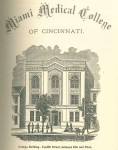 The investigation of the Harrison Horror quickly bore fruit. Cincinnati police detective Charles Wappenstein, Snelbaker, Pinkerton and others hit the medical schools hard, looking for Augustus Devin’s body and for information on the resurrectionists they employed. Professors at the Ohio Medical College and at its rival in Cincinnati, the Miami Medical College, admitted the bodies weren’t just dumped by unknowns who were paid the next day. They contracted for bodies with specific resurrectionists who guaranteed a minimum yearly supply. In fact, it turned out that Cincinnati was something of a hub of the corpse trade, the main city to and from which dead bodies would be shipped from smaller cities in the region.
The investigation of the Harrison Horror quickly bore fruit. Cincinnati police detective Charles Wappenstein, Snelbaker, Pinkerton and others hit the medical schools hard, looking for Augustus Devin’s body and for information on the resurrectionists they employed. Professors at the Ohio Medical College and at its rival in Cincinnati, the Miami Medical College, admitted the bodies weren’t just dumped by unknowns who were paid the next day. They contracted for bodies with specific resurrectionists who guaranteed a minimum yearly supply. In fact, it turned out that Cincinnati was something of a hub of the corpse trade, the main city to and from which dead bodies would be shipped from smaller cities in the region.
Finally it was another janitor, this one at the Miami Medical School, who broke the case wide open. When Snelbaker, who had received a tip that the body of Augustus Devin had been at the school, showed up with a search warrant, the janitor was squirrely. He got even squirrelier when Snelbaker prepared to dig up the basement looking for Augustus Devin’s body. Finally he cracked, telling him the droid they were looking for was not there (the body of an elderly woman was buried under the cellar floor instead), but he had information about where it might be.
 He confessed that a certain Gabriel had approached him in May saying he had permission from the school’s Anatomy professor Dr. Clendenin to use the cellar during the summer break to store bodies and pack them for shipment. The teachers were almost never around, the facilities spacious and private. It was during his month in the Miami Medical School basement that “Gabriel” had robbed the graves of Augustus Devin and John Scott Harrison.
He confessed that a certain Gabriel had approached him in May saying he had permission from the school’s Anatomy professor Dr. Clendenin to use the cellar during the summer break to store bodies and pack them for shipment. The teachers were almost never around, the facilities spacious and private. It was during his month in the Miami Medical School basement that “Gabriel” had robbed the graves of Augustus Devin and John Scott Harrison.
Gabriel was one of many names used by Charles Morton, alias Dr. Morton, alias Dr. Christian, alias Dr. Gordon, the most infamous resurrection man of his day. A University of Michigan medical school dropout, he ran a body-snatching operation of staggering dimensions, supplying medical schools in Ohio and Michigan with hundreds of bodies stolen from graves in Ohio, Indiana and Pennsylvania. In January of 1878, he had been caught in Toledo, Ohio, sending bodies to the University of Michigan medical school in Ann Arbor and was imprisoned for the crime. While behind bars, he received a bundle of letters from Ann Arbor. He was handed them in the prison guard’s office and quickly threw them in the fire, shoving his foot through the grating to stamp them down into the flames. The guard pulled him away, and Woodlawn Cemetery trustee (and all around cool guy) William H. Scott fished the letters out before they could be destroyed.
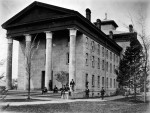 They were a little charred, but still legible in their entirety. They were from “William J. Jones & Co.,” an apparent accomplice in Morton’s extensive resurrection business. The writer complained that one of the “stiffs” Morton had sent was too “tender,” told him not to go younger than 14 in the future because the University of Michigan had rejected the body, and contracted for another 70 bodies. There was a reference to 60 bodies Morton had recently delivered to Columbus and a warning that he should probably move on from Toledo because it was getting too hot. Enclosed was $90 cash.
They were a little charred, but still legible in their entirety. They were from “William J. Jones & Co.,” an apparent accomplice in Morton’s extensive resurrection business. The writer complained that one of the “stiffs” Morton had sent was too “tender,” told him not to go younger than 14 in the future because the University of Michigan had rejected the body, and contracted for another 70 bodies. There was a reference to 60 bodies Morton had recently delivered to Columbus and a warning that he should probably move on from Toledo because it was getting too hot. Enclosed was $90 cash.
A week later, Morton suddenly broke out in pustules. Prison physicians diagnosed him with small pox and sent him to the Toledo pest house. He was its only guest at the time, and was guarded by two men. On the night of January 25th, a lynch mob approached the guards, demanding that Morton be let out so they could hang him for his many outrages. Morton cleverly told the guards to say he’d be right out. The mob didn’t expect that, and outside of their drunken bluster, they weren’t actually keen to get their hands all over a smallpox victim. The crowd quickly dispersed.
Then, when his guards were having dinner the evening of January 29th, Morton escaped. He was supposedly in a locked room, but either the guard/s unlocked it or he got a duplicate key. A search of the area turned up nothing. It suddenly dawned on prison officials that they had been had. A parade of new doctors examined samples from Morton’s skin lesions and discovered he didn’t have smallpox at all. He had simply used Croton oil, a caustic irritant that when applied to skin can cause swelling, blistering and exfoliation, to mimic its symptoms. He didn’t even do all that good of a job of it. One physician who had examined him admitted there were no pustules under his hair or anywhere where his hands couldn’t reach. It was widely believed that some of the doctors had deliberately helped Morton because of his profession.
Where he went for the next few weeks is unknown, but the Harrison investigation discovered that Morton had arrived in Cincinnati in March and checked into a boarding house on Vine and Ninth (three blocks from the Ohio Medical School) with a beautiful young blonde he called his wife. He told the boarding house proprietors that he was a doctor, but that he loved night fishing, which is why he was out every night from 8:00 PM until 4:00 AM. He did not explain why he carried two people-sized canvas bags with him every time he “went fishing” and why his carriage was covered in mud when he got back. Nor did he explain why his so-called wife often accompanied him on his fishing expeditions dressed in men’s clothing.
The couple checked out of the boarding house without notice on the day John Scott Harrison’s body was discovered hanging in the cadaver chute. They were believed to be heading for Canada, but that’s what the authorities thought when he escaped from the pest house too, and they were wrong.
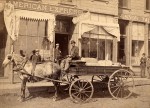 It was Morton’s Ann Arbor connection that the Miami Medical College janitor told Snelbaker about, providing a key clue. He said many of the bodies Morton had stolen were sent to the University of Michigan Medical College, and he was pretty sure based on the dates that Augustus Devin was one them. Morton had packed the bodies in barrels addressed to “Quimby and Co.” and shipped them to Ann Arbor via American Express. (Yes, the credit card company. It started out as an expedited shipping service, hence the name.) Colonel Snelbaker et al. immediately departed for Ann Arbor where they traced the barrels to the medical college. Armed with a warrant and accompanied by the Ann Arbor sheriff, they searched the UoM Medical College over the strenuous objections of Dr. Herdman, the Demonstrator of Anatomy, who insisted they hadn’t received bodies from Cincinnati in weeks.
It was Morton’s Ann Arbor connection that the Miami Medical College janitor told Snelbaker about, providing a key clue. He said many of the bodies Morton had stolen were sent to the University of Michigan Medical College, and he was pretty sure based on the dates that Augustus Devin was one them. Morton had packed the bodies in barrels addressed to “Quimby and Co.” and shipped them to Ann Arbor via American Express. (Yes, the credit card company. It started out as an expedited shipping service, hence the name.) Colonel Snelbaker et al. immediately departed for Ann Arbor where they traced the barrels to the medical college. Armed with a warrant and accompanied by the Ann Arbor sheriff, they searched the UoM Medical College over the strenuous objections of Dr. Herdman, the Demonstrator of Anatomy, who insisted they hadn’t received bodies from Cincinnati in weeks.
He was lying like a rug. In three massive pickling vats, the investigators found 40 bodies, men, women, children, black and white, in varying states of decomposition. Snelbaker had a surly janitor pull them all out so he could attempt identification of any body that might be that of Augustus Devin. He saw one likely candidate, but didn’t feel comfortable making a conclusive identification. He returned to Cincinnati on June 13th, and was back the next day with Augustus’ 18-year-old brother Bernard Devin and George Eaton.
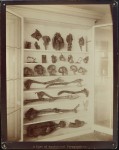 The pile of bodies, no longer dripping the pickling solution of salt and saltpeter, had taken on an eerie lifelike appearance. The hair had dried and, injected with red lead (lead(II,IV) oxide) for their preservation until the fall and winter terms, the corpses’ skin had a pinkish hue. Three bodies fit the general description of Augustus Devin. At first Bernard and George disagreed on which was Augustus, but ultimately Bernard, who had helped care for his brother during his long illness, convinced George that his identification was the correct one thanks to some scars on his leg, a hole in the wall of his nose and some dental work. Augustus Devin was finally found.
The pile of bodies, no longer dripping the pickling solution of salt and saltpeter, had taken on an eerie lifelike appearance. The hair had dried and, injected with red lead (lead(II,IV) oxide) for their preservation until the fall and winter terms, the corpses’ skin had a pinkish hue. Three bodies fit the general description of Augustus Devin. At first Bernard and George disagreed on which was Augustus, but ultimately Bernard, who had helped care for his brother during his long illness, convinced George that his identification was the correct one thanks to some scars on his leg, a hole in the wall of his nose and some dental work. Augustus Devin was finally found.
The Harrisons, Eatons and Devins met the train carrying Augustus’ body at the North Bend railway station on June 17th. A crowd of hundreds silently filed past the coffin in the freight room, paying their respects, and accompanied the family in a procession to Congress Green Cemetery. There the young man was reburied, four weeks to the day after his first funeral. Volunteers guarded the cemetery every night for weeks.
On June 17th, a grand jury returned an indictment against the Ohio Medical College janitor Marshall for concealing the body of John Scott Harrison, and against Charles Morton, still at large, on two counts of grave robbing, one count for the theft of Harrison’s, one for Devin’s. No indictments were returned against the college faculty. The Harrisons’ desire to see the faculty of the Ohio Medical College and the Miami Medical College face criminal justice thus thwarted, they filed civil suits against the colleges for $10,000 each. The Devin family did the same.
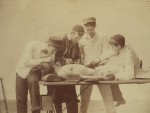 Snelbaker went back to Ann Arbor at the end of June in an attempt to get information from the doctors on Morton’s whereabouts. His discussions with the University of Michigan regents went nowhere. They denied any knowledge of his current abode (even though they, like many medical schools, had a long record of correspondence with him). One Professor McLean admitted that they had incentive to keep their mouths shut whether they knew where he was or not, because if any of the faculty outed him, “it would call down upon the informer the general hatred of all body-snatchers, and might prevent the University in the future from obtaining an adequate supply of material for anatomical purposes.” The trail went cold.
Snelbaker went back to Ann Arbor at the end of June in an attempt to get information from the doctors on Morton’s whereabouts. His discussions with the University of Michigan regents went nowhere. They denied any knowledge of his current abode (even though they, like many medical schools, had a long record of correspondence with him). One Professor McLean admitted that they had incentive to keep their mouths shut whether they knew where he was or not, because if any of the faculty outed him, “it would call down upon the informer the general hatred of all body-snatchers, and might prevent the University in the future from obtaining an adequate supply of material for anatomical purposes.” The trail went cold.
The Medical College of Ohio merged with the University of Cincinnati College of Medicine in 1896. The old building with its cadaver chute is long gone, sadly. Also gone are all records of Benjamin Harrison’s civil suit against the college and the outcome of the criminal cases. They were destroyed when the Hamilton County Court House was burned to the ground in the Cincinnati Courthouse riots of 1884. If Morton was ever arrested and tried for Harrison Horror, there are no records of that either.
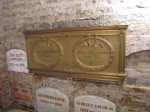 In direct response to the case, Illinois, Indiana, Iowa, Michigan and Ohio passed Anatomy Acts that allowed medical schools to use unclaimed bodies of people who died in the care of the state (the indigent in hospitals or insane asylums, orphans, convicts) for anatomical dissection. Previous laws had prohibited dissection if anybody at all objected, be it acquaintance, friend or family. The enlarged pool of corpses still wasn’t enough to fill the demand as new medical schools continued to crop up, and enforcement of the new laws was less than vigorous. Resurrectionists maintained their profitable “profession” in the United States well into the 20th century.
In direct response to the case, Illinois, Indiana, Iowa, Michigan and Ohio passed Anatomy Acts that allowed medical schools to use unclaimed bodies of people who died in the care of the state (the indigent in hospitals or insane asylums, orphans, convicts) for anatomical dissection. Previous laws had prohibited dissection if anybody at all objected, be it acquaintance, friend or family. The enlarged pool of corpses still wasn’t enough to fill the demand as new medical schools continued to crop up, and enforcement of the new laws was less than vigorous. Resurrectionists maintained their profitable “profession” in the United States well into the 20th century.
In December of 1879 John Scott Harrison’s body would find a permanent, undisturbed home next to his parents in the William Henry Harrison Tomb State Memorial in North Bend. George and Arch Eaton are buried there as well.
Oh my gosh! That was great work! Thank you thank you thank you, I loved reading it. I’d never heard of this, it was a wonderful idea for Halloween. Thanks again, keep on keepin’ on
Thank you for doing this! Such fun to read in today’s world of quick links and snippets. I think you made us all feel very pampered as readers:) :notworthy:
WOW, what a story. Thank you!
I am exhausted! The tension was extreme as I zoomed along with my reading wanting to know every detail of this horrific historic saga. It is a shame the court records were gobbled by a fire; There would have been – even now / and by a mere observer – a great sense of justice knowing the Medical School officials as well as ‘the body snatchers’ had been punished / by big fines as well as prison time.
How will you ever surpass having spotlighted this dark tale of woe? Next Halloween — YOU’LL JUST HAVE TO DIG A LIL’ DEEPER!
When I was researching this story (something I’ve been doing for close to two years), I had a wonderful exchange with University of Michigan’s archivist about trying to find some records of the trial and its outcome. The Devins were said to be planning a lawsuit about the UofM as well, so she searched high and low for any primary material they might have on the case but alas came up empty. If she had found something, we were going to jointly publish it. I still harbour a secret hope something will turn up in a dusty old manilla folder somewhere.
Oh lawds, I can’t even think about next Halloween. I suspect I’ll still be recovering from the effort of writing this a year from now. I’ll probably post a picture of busted jack o’ latern vomitting seeds and call it a day.
A monumental work! (see what I did there?)A fascinating story well told; until now I thought my home town of Edinburgh had all the best resurrectionist stories!
Edinburgh will always have the most famous ones — Burke and Hare are the gold standard of resurrectionist infamy — but the incredible persistence of the practice in the US coupled with the way it has disappeared from the public consciousness in modern times give it the advantage of suprise.
What a wonderful story–thank you so much for telling it.
Thank you for persisting in reading it. :thanks:
Fantastic!!! The best Halloween themed story I’ve read in years!
Wow, thank you! I’m glad I waited for a thematically relevant time to finally write it up. :thanks:
Bravo! I couldn’t wait to log in this morning. Make sure you get a fair deal for the screenplay rights. 👿
Now here’s food for thought. Similar shenanigans continue to this day. Do you know where that bone graft came from?
(I remember this story because local hospitals were involved.)
From Wikipaedia: Biomedical Tissue Services (BTS) was a Fort Lee, New Jersey, human tissue recovery firm that was shut down by the U.S. Food and Drug Administration (FDA)[1] on October 8, 2005,[2] after its president, Dr. Michael Mastromarino, and two other employees were convicted of illegally harvesting human bones, organs, tissue and other cadaver parts from individuals awaiting cremation, for forging numerous consent forms, and for selling the illegally obtained body parts to medical companies without consent of their families.
In late 2005, the New York City Police Department investigated Michael Mastromarino and his company BTS for allegedly selling stolen human body parts.[4] The probe was first reported by the New York Daily News in October 2005, and led to a number of exhumations, including one of a Queens, New York, woman who had had many of her bones removed and replaced with PVC piping, which is a typical industry practice for cosmetic reconstruction of tissue donors.
Bottom line: “Overall, about 10,000 patients in the United States and Canada received graft tissue from BTS.” :ohnoes:
I remember when that story was “ripped from the headlines” for a Law & Order episode! So crazy. I had cadaver bone tissue put in my jaw when I had oral surgery a couple of years ago. No idea where it came from. :ohnoes:
You’re right about the screenplay. The Harrison Horror has great movie potential.
I love it! I’ve been to that cemetery and Harrison’s monument once before, but now have to go back!
You must look for Augustus Devin’s grave! There are many pictures of the Harrison memorial and of Congress Green in general, but I couldn’t find any of his grave.
Yikes, it just occurred to me that we have family buried in Cincinnati – or should I say “buried”?? While avoiding the photos, this was a great story, a real nail-biter for Halloween! Thanks!
If they were buried long enough ago, they really might not still be buried there. Time to get a GPR and go exploring. :yes: Thank you for reading!
“I love night fishing.” I’ve got to remember that one!
It’s quite a versatile euphemism. It could cover everything from pick-pocketing to whoring to serial killing.
On the other hand, where would today’s medicine be without all the body snatchers of the past? Personally, once I’m dead, I don’t care what happens to my body.
http://www.jhna.org/images/Vol1Issue2/Wolters/denys007det6.jpg
Oh the medical schools had a solid argument, and as disasteful as it is that the bodies of the unclaimed poor would be sacrificed on the altar of medical knowledge, the Anatomy Act resolved the issue neatly in the UK. In fact, from one perspective, Charles Morton’s practices democratized the process because he targeted the wealthy so he could make additional moneys from selling their fancy burial clothing and accessories.
Once I had the opportunity to witness a liver transplantation, i.e. standing right next to the operation desk, and one way or another, also other body parts are routinely ‘harvested’ these days.
My daily bike route used to bypass a particular company, specialized in the business of human tissue, e.g. corneae etc. However, having read your marvelous horror story, I bet I can fly now.
Is organ donation the default in Denmark now? I know in some countries you have to opt out if it’s important to you to keep your organs after your death. I’ve been a donor since I first got my license at 16. Take it all, kids. I ain’t using it no more.
Bravo, livius. Well done. Sure am glad I got to read it in one go, though. Your last comments got to the core of things, I think. Our culture has an odd take on death that has evolved from a close relationship to one of distance. I suspect that the desire for our dead to stay buried is part of that wish to both respect our dead and keep them at a distance.
Great job, Livius. But you know you’ll have to do this again next year! Looking forward to it.
An absolutely fascinating story. Thank you for telling it so well.
Wonderful! When is the next series? Hurry 😆
I really enjoyed this. You’ve done a wonderful job with your research.
I know it’s been a couple of years, but you should look into the story of Dr. McDow’s (also spelled McDowell) who petrified his daughter in the Mark Twain cave in Hannibal, MO. Twain (or should I say Sam Clemens) would take the local girls in, unscrew the lid on the canister, and pull her up by her hair! I won’t give up the whole story here, hus giving your readers something to look forward to.